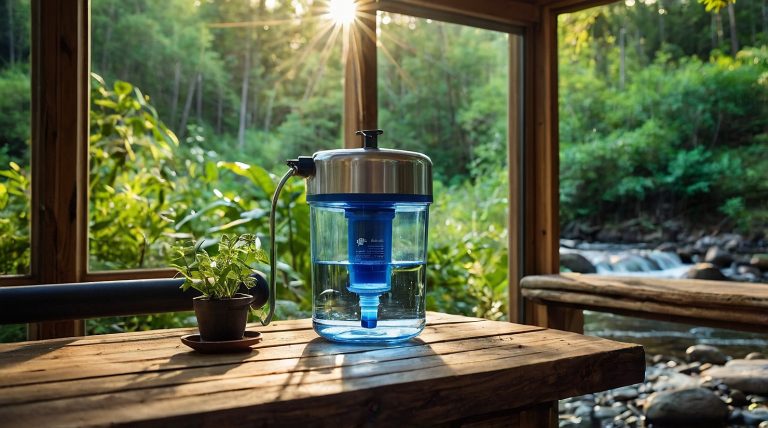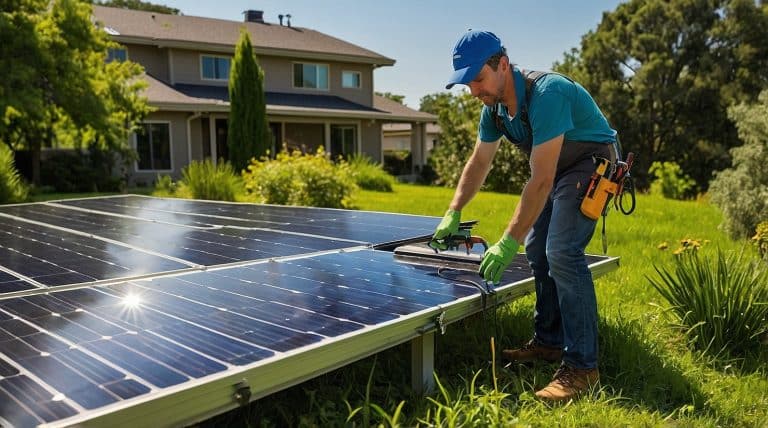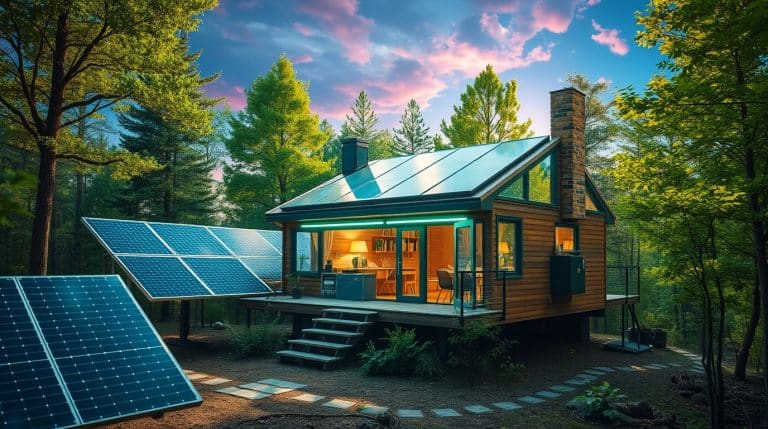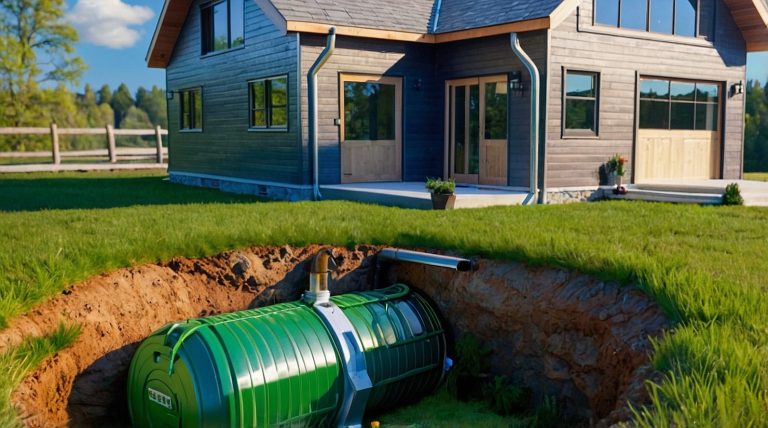Top 5 Picks: Best States for Homesteading in 2025
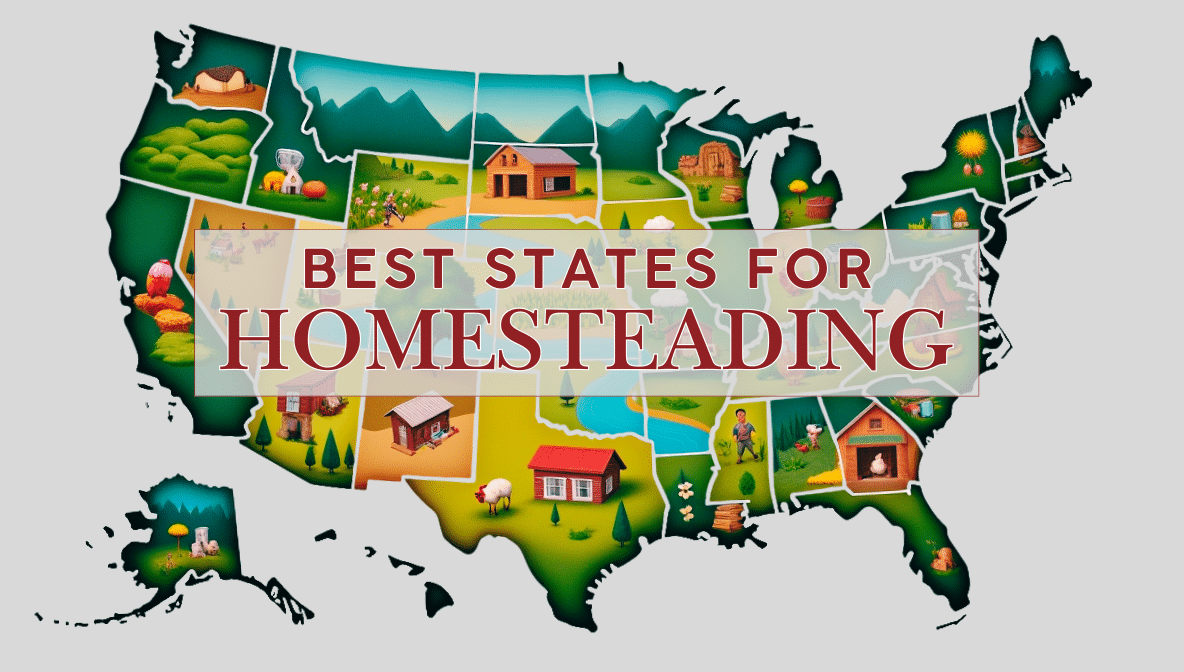
Dreaming of a simpler life where you grow your own food, raise chickens, and harness your own power? You’re not alone. Homesteading is more than a trend—it’s a return to sustainable living and self-sufficiency that’s captivating families across the country. But where should you start your journey?
Choosing the right state for homesteading is a critical first step. From states with fertile soil and long growing seasons to those that offer homestead exemptions and favorable local laws, the options are diverse. In this guide, we’ll explore the best states for homesteading in 2025.
We’ll consider essential factors like property taxes, natural resources, and community support to help you find the perfect place to establish your homestead. Whether you’re drawn to vast open land, a thriving homesteading community, or opportunities for sustainable living, this post will guide you toward your dream lifestyle.
Factors to Consider When Choosing the Best States for Homesteading
Homesteading is a big change, but the right preparation can lead to a fulfilling and sustainable lifestyle. Careful research and planning are essential. Consider these key factors to guide your decision on the best states for homesteading.

How to Live Off Grid: Ultimate Guide for Beginners in 2025.
Cost of Land and Living
The cost of land and living is a contributing factor in choosing the best states for homesteading. Affordable property costs, favorable property taxes, and access to homestead exemptions can significantly impact your budget. States like Oregon and Tennessee are popular choices due to their financial advantages for homesteaders, including property tax exemptions and automatic homestead exemptions.
Evaluating each state’s local and state tax burdens is essential to avoid unexpected expenses. Exploring states with low property costs and sustainable living incentives will help you make an informed decision. Balancing low costs with supportive homesteading laws makes finding the best homesteading location easier and more attainable.
Climate and Growing Season
The climate and growing season play a crucial role in selecting the best states for homesteading. Homesteaders rely on fertile soil and long growing seasons to cultivate crops and maintain a thriving homestead lifestyle. States with seven- or eight-month growing seasons, like Tennessee or Texas, offer ideal food and sustainable farming conditions.
Harsh winters in some regions can limit farming activities, but states with mild winters simplify year-round food production and livestock care. You can create a successful and self-sufficient homestead by prioritizing states with favorable weather conditions and distinct growing seasons. The right climate is a cornerstone of the homesteading lifestyle.
Water Access
Water access is one of the most important considerations when identifying the best states for homesteading. Homesteading relies on sufficient water for growing crops, raising livestock, and daily living needs. States like Oregon and Texas support rain catchment systems and offer favorable rainwater collection laws, making them attractive options for sustainable homesteading.
Researching water rights, rainfall annually, and access to natural resources ensures that your chosen location meets your homestead’s needs. Access to well water or irrigation can make homesteading viable even in drier climates. Understanding state laws that protect water access is essential for long-term homesteading success.
Local Regulations
Local regulations can heavily influence your choice of the best states for homesteading. Favorable homesteading laws provide financial protections, such as homestead exemptions that shield primary residences from creditors. States with flexible local laws and minimal restrictions on farming practices and structures are ideal for creating a thriving homestead.
Urban homesteading may face stricter regulations, while rural areas often offer more freedom for sustainable living. Researching state and local regulations helps ensure your homesteading lifestyle aligns with legal requirements. You can establish a successful and sustainable homestead lifestyle by choosing states with supportive homesteading communities and favorable local laws.
Best States for Homesteading: A Detailed Look
Here are some of the best states to buy land for homesteading, not in any particular order, for no state is perfect.
Tennessee
With its rolling hills and fertile valleys, Tennessee has long been a haven for those seeking a simpler life. The Volunteer State offers a compelling blend of affordability, agricultural opportunity, and a supportive legal framework, making it one of the best states for homesteading. From the misty peaks of the Smoky Mountains to the rich farmland of the western plains, Tennessee offers diverse landscapes perfect for establishing your self-sufficient dream.
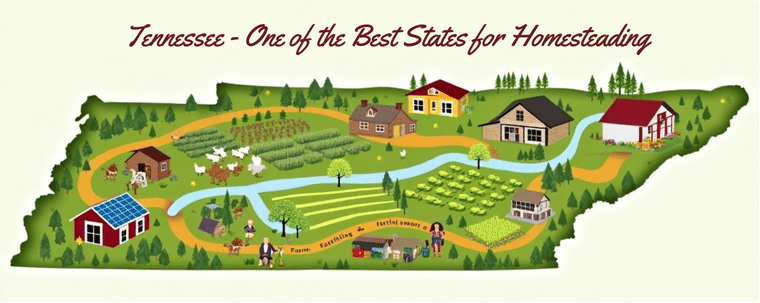
Affordable Land and Low Taxes
One of the most attractive aspects of homesteading in Tennessee is the relatively low cost of land. Compared to other popular homesteading states, Tennessee boasts significantly lower property prices, making it easier to acquire a sizable plot for your homestead. This affordability extends to property taxes as well, allowing you to invest more of your resources into building your self-sufficient lifestyle.
Favorable State Laws and Regulations
Tennessee’s government has adopted a generally hands-off approach to land use, providing homesteaders with considerable freedom. The state’s Right to Farm Act protects farmers and homesteaders from nuisance lawsuits, allowing you to pursue agricultural activities without undue interference.
Furthermore, another reason why Tennessee is one of the best states for homesteading is that it allows for rainwater harvesting, a crucial component of self-sufficient living, and has minimal restrictions on other homesteading practices like raising livestock and building structures on your property. The University of Tennessee Extension provides valuable resources for understanding state regulations related to agriculture and land use.
Thriving Agricultural Landscape
Tennessee enjoys a long growing season, approximately nine months in many areas, enabling homesteaders to cultivate a wide variety of crops. The fertile soil and ample rainfall create ideal conditions for growing fruits, vegetables, and herbs. Raising livestock is also a popular pursuit in Tennessee, with ample pastureland available. Whether you dream of a bountiful vegetable garden or raising your own livestock, Tennessee offers the resources and climate to support your agricultural endeavors.
Beyond its practical advantages, Tennessee also boasts a strong sense of community. The state is known for its friendly residents and rich cultural heritage, making it easy to connect with like-minded individuals and build a supportive network. Numerous farmers’ markets and agricultural organizations provide opportunities to share knowledge and resources, further enhancing the homesteading experience.
Idaho
Idaho consistently ranks as one of the best states for homesteading, and for good reason. The Gem State offers a unique blend of fertile land, abundant natural resources, and a supportive legal environment that fosters self-sufficient living.
Idaho’s Appeal for Homesteading?
Several factors contribute to Idaho’s appeal for homesteaders:
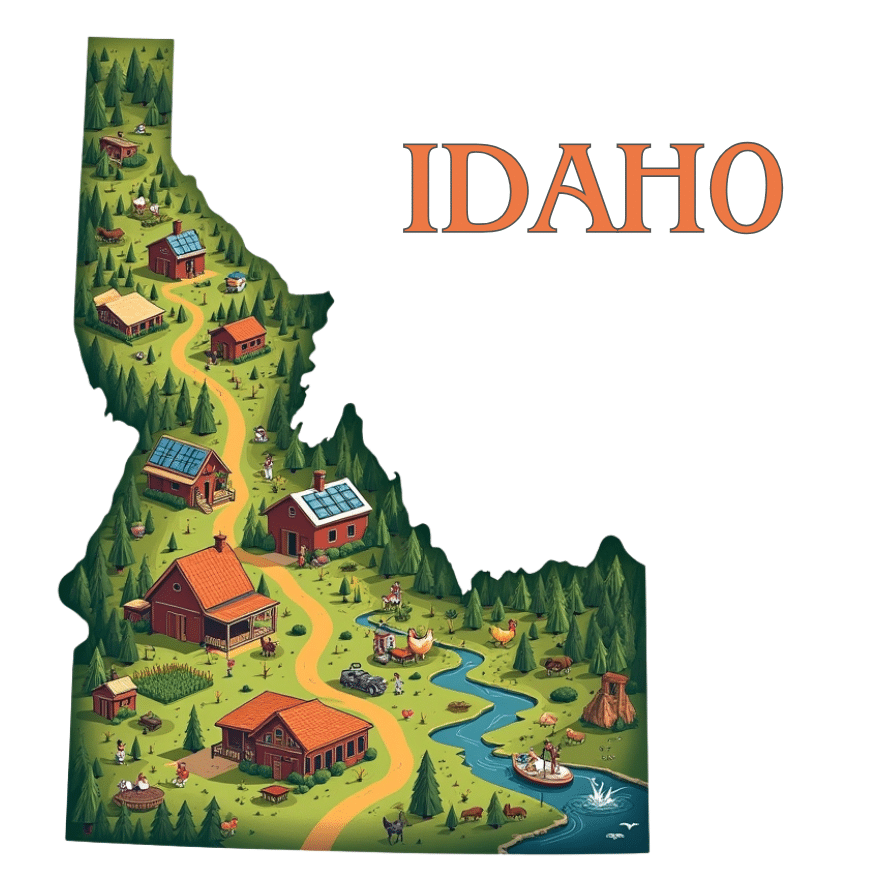
Fertile Land: Idaho boasts rich, volcanic soil ideal for cultivating a wide range of crops. This fertile ground is a cornerstone of successful homesteading, enabling self-sufficiency in food production.
Abundant Water Resources: With plentiful rivers, lakes, and aquifers, Idaho provides ample water for irrigation, livestock, and daily needs. Water access is a crucial consideration for homesteaders, and Idaho’s resources offer a significant advantage. Explore Idaho’s water resources.
Generous Creditor Protection: Up to $100,000 and existing homesteading communities offer peace of mind.
Favorable Climate: Idaho experiences four distinct seasons, providing ample sunshine for growing seasons while also offering the opportunity to prepare and preserve food for the colder months. This predictable climate allows homesteaders to plan and adapt their activities accordingly.
Homesteading-Friendly Laws: Idaho maintains a relatively lenient regulatory environment concerning homesteading activities, including relaxed building codes and property tax incentives in certain areas. Research Idaho state laws and regulations.
Strong Community: Idaho fosters a vibrant community of homesteaders who offer support, resources, and shared knowledge. This network can be invaluable for newcomers navigating the challenges and rewards of self-sufficient living.
Land Availability and Cost
While Idaho’s popularity has led to increased land prices in certain areas, affordable options are still available, especially for those willing to explore rural locations. Careful research and planning are essential when searching for land suitable for your homesteading goals. Consider factors such as acreage, access to utilities, proximity to communities, and zoning regulations.
Getting Started with Homesteading in Idaho
Embarking on a homesteading journey requires thorough preparation and research. Connecting with local homesteading communities, attending workshops, and consulting with experienced homesteaders can provide valuable insights and guidance. University of Idaho Extension offers resources and educational programs related to agriculture, horticulture, and other relevant topics for homesteaders.
Missouri
Missouri shines as a homesteading-friendly state, beckoning those seeking self-sufficiency and a connection to the land. With a blend of relaxed regulations, diverse landscapes, and a moderate climate, the “Show-Me State” offers a fertile ground for building your dream homestead making it one of the best states for homesteading.
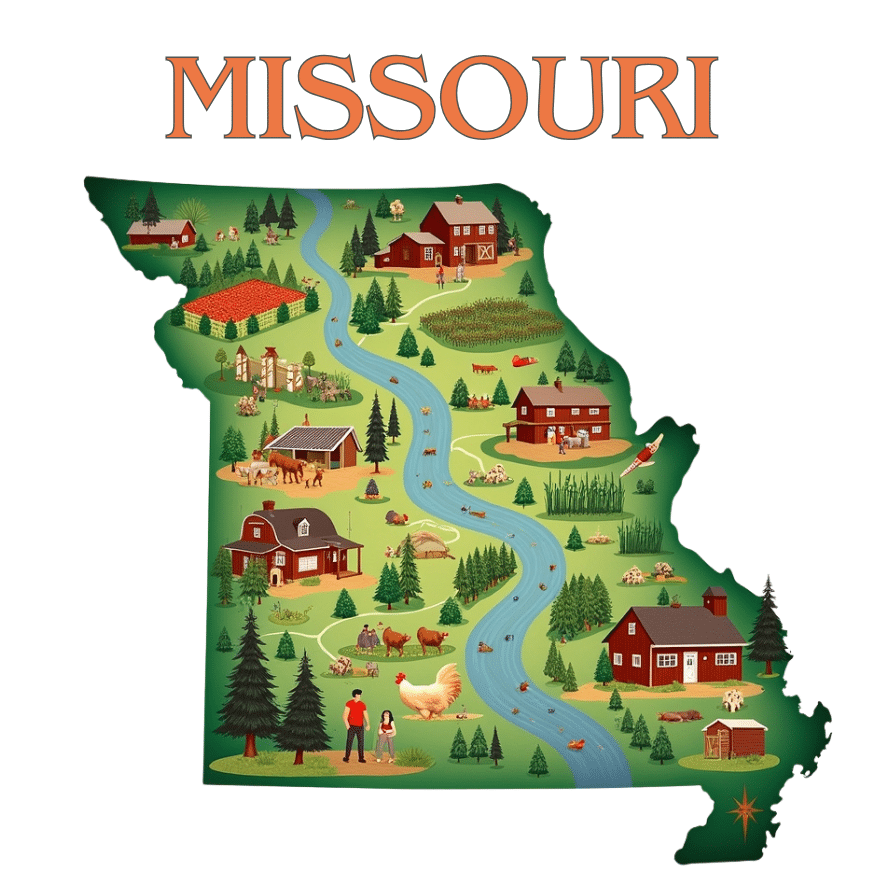
Regulatory Freedom for Homesteading
One of Missouri’s biggest draws for homesteaders is its relatively lenient regulatory environment. Compared to some states with stricter building codes and land use restrictions, Missouri offers greater freedom to develop your property as you see fit.
This can translate to less red tape when building your own home, establishing outbuildings, or implementing alternative energy systems. The Missouri Department of Agriculture provides resources and support for farmers and rural landowners, further enhancing the state’s appeal to homesteaders.
Diverse Landscapes and Abundant Resources
From the rolling hills of the Ozarks to the fertile plains of the north, Missouri boasts a diverse landscape that caters to various homesteading preferences. Whether you envision a secluded woodland retreat or a sprawling farm, you’re likely to find a suitable niche in Missouri. The state’s rich soil is ideal for cultivating a wide range of crops, while ample rainfall—averaging around 40 inches annually—supports thriving gardens and livestock. The legality of rainwater harvesting in Missouri further empowers homesteaders to manage their water resources effectively.
Four Seasons and a Bountiful Harvest
Missouri experiences all four seasons, although in a more moderate fashion than some other states. Summers are typically warm and humid, perfect for growing a wide array of vegetables and fruits. Winters, while generally milder than in northern states, can still bring occasional snowfalls. This balance allows for a productive growing season and the opportunity to enjoy the distinct beauty of each season. The Missouri Master Gardener program is an excellent resource for learning about gardening and maximizing your harvest in the state’s climate.
While Missouri does experience some natural disasters such as tornadoes and flooding, resources like the Missouri State Emergency Management Agency provide valuable information on preparedness and response, ensuring homesteaders can face these challenges with resilience.
Oregon
Oregon stands out as a homesteader’s haven due to its vibrant communities, fertile soil, and strong support for sustainable living, thus making it one of the best states for homesteading. From lush valleys to scenic coastlines, the state’s diverse landscapes provide ideal conditions for cultivating crops, raising livestock, and enjoying outdoor activities.
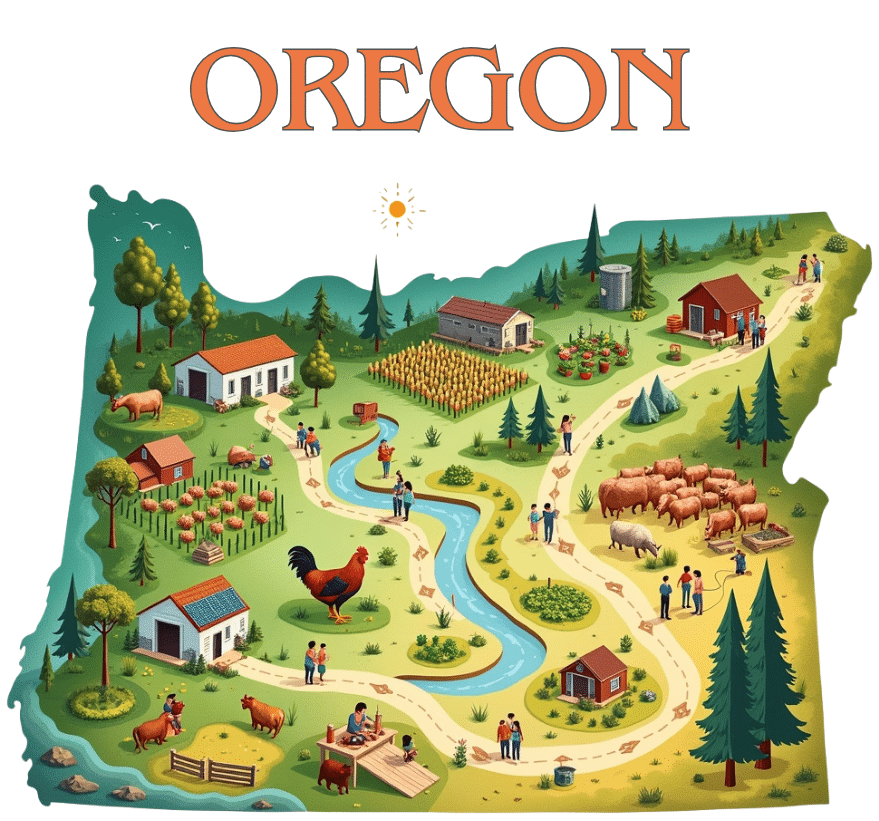
Fertile Soil and Thriving Agriculture
Oregon is renowned for its fertile soil, making it an excellent choice for growing food. The state’s climate supports a wide range of crops, from vegetables and fruits to grains and herbs, ensuring year-round agricultural potential.
Whether you’re establishing a small farm or tending a backyard garden, Oregon offers the resources to thrive. Learn more about Oregon’s agricultural potential at Oregon State University Extension Service.
Homesteading-Friendly Laws and Community Support
Another reason why Oregon is considered one of the best states for homesteading is their favorable homesteading laws particularly for families and individuals seeking self-sufficiency. The state actively supports rainwater collection and other sustainable practices, allowing homesteaders to maximize natural resources. Additionally, Oregon’s homesteading communities are well-connected, fostering knowledge-sharing and collaboration. Local farmer’s markets and co-ops provide opportunities to sell excess produce and engage with like-minded individuals. For more details, visit Oregon Farm Link.
Property Costs and Considerations
While Oregon’s popularity has driven up property costs in certain areas, affordable options can still be found in rural regions. Researching land prices and zoning regulations is essential before purchasing property. Be mindful of building restrictions and compliance with state farming laws to ensure a smooth start to your homesteading journey. Websites like LandWatch and Oregon Farm Link can help identify available properties suited for homesteading.
Oregon’s combination of natural beauty, supportive laws, and a strong homesteading culture makes it a top contender for anyone considering a self-sufficient lifestyle
Maine
Maine, known as the Pine Tree State, offers a unique blend of rugged beauty, abundant natural resources, and a thriving homesteading community. With its vast expanses of undeveloped land, low property taxes in certain areas, and four distinct seasons, Maine presents a compelling case for those seeking a self-sufficient lifestyle making it our last of the best states for homesteading. While the winters can be challenging, the independent spirit of Maine, coupled with its supportive agricultural network, makes it an attractive destination for modern homesteaders.
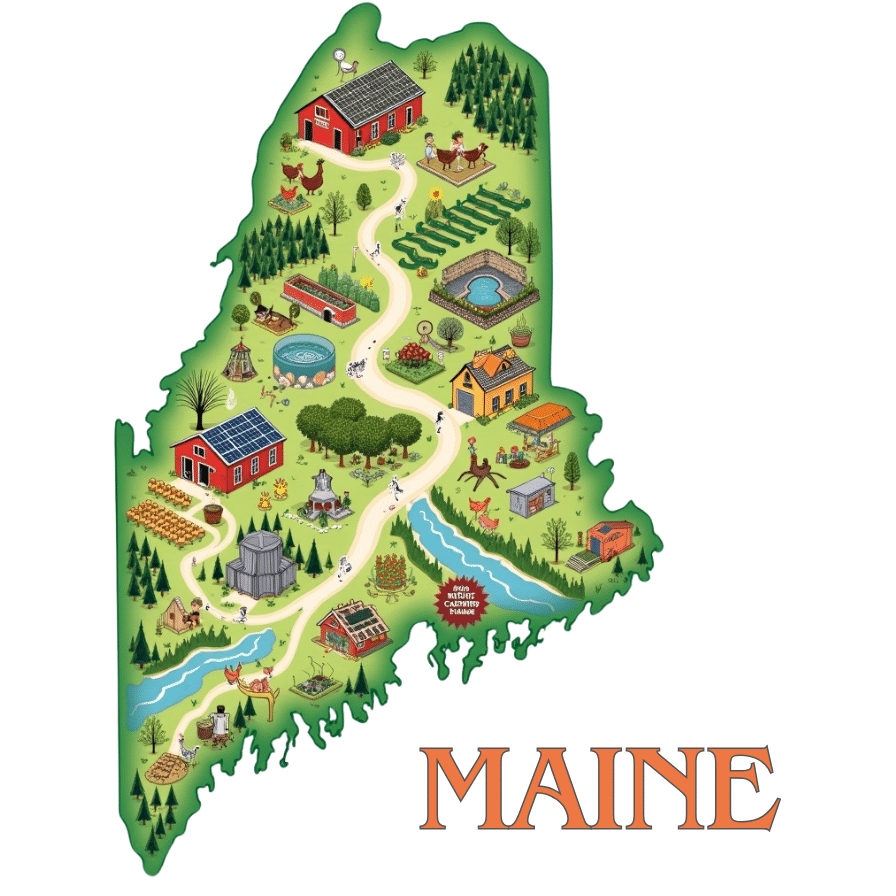
Land Availability and Affordability
One of Maine’s biggest draws for homesteaders is the availability of affordable land, particularly in the northern and central regions. Websites like Lands of America and Zillow frequently list properties suitable for homesteading, ranging from small, wooded lots to larger acreage with existing farm infrastructure.
This relative affordability compared to other New England states allows homesteaders more flexibility in their budgets, freeing up resources for investments in infrastructure, livestock, or renewable energy systems.
Climate and Growing Season
Maine’s climate, while characterized by long, cold winters, still offers a viable growing season. Resourceful homesteaders can extend the growing season through techniques like season extension using cold frames or greenhouses. The Maine Department of Agriculture, Conservation and Forestry provides valuable resources and support for farmers and gardeners, including information on soil testing, pest management, and crop selection suitable for Maine’s climate. Focusing on cold-hardy crops like kale, spinach, potatoes, and certain root vegetables can ensure a successful harvest, even in shorter growing seasons. Learning to preserve the bounty through canning, freezing, and root cellaring is a crucial skill for Maine homesteaders.
Community and Resources
Maine boasts a strong and supportive homesteading community. Organizations like the Maine Organic Farmers and Gardeners Association (MOFGA) offer educational programs, workshops, and networking opportunities for both seasoned and aspiring homesteaders. Connecting with local farmers’ markets and agricultural fairs can also provide valuable insights, resources, and a sense of community. This network of experienced homesteaders offers a wealth of knowledge, helping newcomers navigate the challenges and celebrate the rewards of self-sufficient living in Maine.
Other States to Consider
These states offer homesteading opportunities, but keep their drawbacks in mind. Michigan gives urban homesteading options. Montana boasts spectacular landscapes but harsh winters, ideal for rugged homesteaders.
Arizona offers low land costs but blazing summers. Alaska has incredible scenery but short growing periods and remote living, posing a challenge even for experienced homesteaders seeking ideal homesteading opportunities.
Conclusion
There is no single perfect state for homesteading—each has its unique charms and challenges. The best states for homesteading offer a mix of affordability, favorable homesteading laws, and opportunities for a sustainable lifestyle. From fertile soil and long growing seasons to supportive communities and accessible natural resources, each state brings its own advantages.
When choosing your homesteading location, consider key factors like property taxes, climate, local regulations, and water access. Visiting potential homesteading locations and connecting with local homesteading communities can provide invaluable insights. Balancing affordability with sustainability and aligning your goals with state offerings will set you up for success.
Ultimately, your dream homestead is achievable with careful planning and adaptability. By selecting one of the best states for homesteading in 2025, you’ll be well-positioned to enjoy a self-sufficient lifestyle filled with thriving crops, productive seasons, and a sense of accomplishment for years to come.

